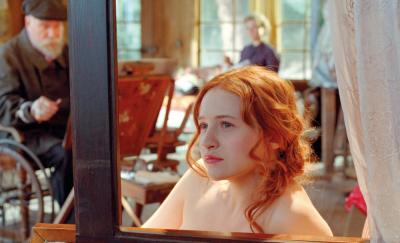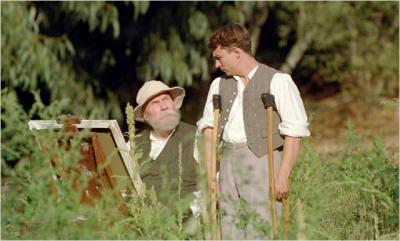By: debbie lynn elias
Sumptuous and beauteous, with RENOIR, director Gilles Bourdos has captured not only the very essence of a Renoir painting, but elicits an ethereal aura and visual design that gives one the sense that Renoir himself painted the very imagery we see on the screen before us. Honing in on the summer of 1915 in Cagnes-sur-Mer, we are privy to a brief chapter in the life of the master, concentrating on his relationship with 15-year old Andree Heuschling. Although the film relates that Heuschling was referred to Renoir as a potential model by Renoir’s wife, who was deceased, in truth and fact, it was at the suggestion of Henri Matisse that Heuschling made her way to the house, and possibly even the heart, of 74-year old Pierre-Auguste Renoir. As Fate would have it, Heuschling would prove to be not only Renoir’s final muse and model but an inspiration and first love to his son, filmmaker Jean Renoir.

RENOIR is a visual masterpiece unto itself; breathtaking to look at. Not sharply digitized, but softer with more visual subtlety like a Renoir painting, we are greeted with sun-kissed exteriors, light filled rooms, and then the dark contrast of inner chambers of the Renoir home, and particularly Renoir’s own bedroom. The visual tone is truly as expressive as a Renoir painting and subscribes to Renoir’s mantra of color and that subjects “soak up” color and light. The cinematography of Mark Ping Bing Lee is a testament to that philosophy. We are washed with a serenity reflective of the paintings, the location, the calm of Renoir’s life, the calm pragmaticism of the man himself.
But as beautiful as the film is to watch, the sound design is flawless. We hear every rustle of the breeze as it wafts through the trees or the tall grasses. We hear every ripple, rill, droplet of water be it from rain, a waterfall, walking in the river, the ice and water being poured over Renoir’s hands. We hear the wrapping of bandages on Renoir’s arthritic hands, the touch of a brush, the knife gutting fish. As subtly toned as the visuals are, the sound is exquisitely precise, distinctive, sharp and crystalline. One of the most magnificent tonally artistic marriages I have ever experienced on film.

As writer/director, Gilles Bourdos’ attention to detail in setting the scene for the painting of some of Renoir’s most famous works is meticulously, yet effortlessly done. This isn’t just about a man painting pictures. We get the sense of who Renoir was, what mattered to him, the importance of work ethic and family, his own importance in the household, and we see the familial structure and the father-son relationships, each as distinct and different as the next. Much of this is not only due to the script, but Michel Bouquet’s magnificent performance. Seeing him on screen is like seeing Renoir himself.
Hand and hand with Bouquet is Christa Theret’s Andree. A solid performance, but the revelations of Andree’s true character are less than climactic and Theret seems to lose her understanding of Andree 2/3rd into the film. Likeable is the tacit and methodical nuance Vincent Rottiers brings to son Jean Renoir. An interesting character study to watch, Rottiers speaks with his eyes be it joy, uncertainty, anger or displeasure. His words are few, but his eyes speak volumes.

A soft lilting score by Alexandre Desplat is the final stroke to this exquisite canvas.
RENOIR is a sensitive and serene sanctuary of beauty.
Written and Directed by Gilles Bourdos based on works by Jacques Renoir with Michel Spinosa and Jerome Tonnerre.
Cast: Michel Bouquet, Christa Theret, Vincent Rottiers











